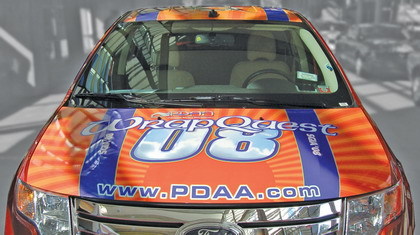Vehicles + Vinyl
Wrapped Up in Vinyl
ST welcomes Rob Ivers in his inaugural column.
Published
15 years agoon

For 2009, Rob Ivers, a 30-year, vinyl-graphics veteran, will author ST’s “Real World Vinyl” column. He offers seminars, video training and hands-on instructional sessions related to vehicle graphics and other vinyl applications. He also serves as certification director for the Professional Decal Application Assn. (PDAA) and created the PDAA VIP installer-certification program that’s been adopted by Arlon, Avery, FLEXcon and MACtac.
I feel privileged to author this column. Many of you don’t know me, so how I got into this business should provide a good introduction. Knowing my background may help you understand my perspective as a vinyl-graphics professional. My goal is to provide you with information to help you cope with the real-world vinyl challenges that confront installers today.
In 1978, I worked for a small company, Novus Windshield Repair of Kansas City, which repaired cracked windshields. We injected resin into the cracks with gentle pressure; rushing the job usually cracked the glass. I spent most of my time at car lots and truck lines. Even when repairing four or five windshields at once, I had lots of idle time. Working on straight commission – and being young, energetic and ambitious — I wanted to make that idle time productive. I decided to find another service to offer the same customers.
Vinyl was a popular tool for various automotive repairs and accents. Repairmen used them to repair dashboards or body-side moldings, as well as to apply pinstripes. Among those, vinyl pinstriping appealed to me, so I started my business, R & B Stripes. I didn’t know anything about it when my vinyl-graphics journey began.
Does that sound familiar? Did you wake up one day and realize you wanted to fabricate and install vinyl signs or vehicle wraps? They look cool, and you thought you could makes lots of easy money in a business with a low startup cost.
AdvertisementVinyl’s (and my) evolution
In 1978, the vinyl-graphics industry was in its infancy. No training schools, classes or books existed, and, of course, personal computers and the Internet hadn’t been invented. I quickly learned how little I knew. All I had were questions. What should I use to clean the surface? How do I remove vinyl? Worse, how do I remove this sticky adhesive?
Today, you’re faced with just as many questions, maybe more. There’s good news — lots of information about vinyl graphics is readily available. But, there’s the bad news — lots of information about vinyl graphics is readily available. Where to start? Is the source reliable? If sources disagree, how do you know which one to trust? Sometimes, hard-won experience serves as the best teacher.
After a year of practice, I could apply much better pinstripes. I also discovered how slight temperature changes dramatically affected vinyl performance. In 1980, I attended a one-day workshop hosted by a distributor. It was introducing a line of 2-, 6- and 24-in-wide rolls of vinyl products. Back then, a 2-in.- wide stripe was considered wide; a 24-in.-wide roll of vinyl seemed huge.
The instructor demonstrated how to apply these wider stripes to vehicles. He applied them dry — that’s right, no application fluid – with few or no bubbles. He also taught us how to hand-cut vinyl graphics to create vinyl logos, lettering and designs that could replace paint. Remember, this predated computers, software or vinyl cutters.
He also showed us how to hand-cut graphics on the backing without cutting through the paper, and introduced us to premask, which enabled the transfer of graphics in one piece to the application surface. He showed us how to trim the graphics on the vehicle without cutting the paint. At the time, this education was way ahead of the curve, and we were shown all of this in one day.
AdvertisementThe techniques I learned that day changed my life. It changed how I thought about vinyl and the directions I could take my business. I believed I could do anything with vinyl, but the truth was, I couldn’t have learned everything about vinyl-graphic application in one day. Honestly, all I really learned was large vinyl graphics could be applied dry with few or no bubbles. I lacked the technique or experience to do the best work I could. Similarly, a would-be vehicle-wrap installer can’t learn everything about design, fabrication and application in a one- or two-day seminar.
Practice makes perfect
Once you know something can be done, and if you’re willing to work hard and practice, you can learn to do it. But just because someone shows you a technique doesn’t necessarily mean it’s the best way to do it. It may or may not be. And, what’s the best way today may not be the best way tomorrow.
For example, in 1982, I landed a job to remove and install graphics for AT&T on 450 vehicles across the state of Missouri. The December temperatures were averaging -10 to -20° F. We worked indoors, but the vehicles were cold when we brought them inside. We had to remove reflective graphics; we’d always used heat to make removal easier, but the reflective vinyl almost always left heavy adhesive residue.
I accidentally discovered I could wet the logo with alcohol, slam the scraper into the edge of the vinyl, and the graphic would shatter and fly off in big pieces without scratching the paint or, more importantly, leaving adhesive behind.
My next big job involved installing hundreds of trailer graphics on flat, riveted surfaces. In those days, we fabricated graphics with 2-mil, cast vinyl that was screenprinted, die-cut or both, always with premask – of course, air-egress vinyl didn’t exist.
AdvertisementWe applied the graphics, removed the premask and poked holes with an air-release tool. Using a rivet brush and propane torch, we conformed the vinyl around the rivets until it was “painted on” tight. We became very fast and performed a nearly perfect, bubble-free installation.
Corrugated-surface trailers became my bread and butter. Back then, we were told to never stretch the vinyl, nor apply it to complex curves. I learned about vinyl memory and how to apply vinyl without stretching the media, which could cause lifting.
Now, of course, vinyl shops are usually fabricating digitally printed graphics with an air-egress film and laminate. I’ve developed a completely new combination of techniques for applying these graphics to a trailer with rivets. I don’t use squeegees; instead, I implement special 3M’s PowerGrip Rapid Roller CPA-2 and GForce Products LLC’s RollePro rollers that let the installer work quickly. Next month’s column, “Rivet Rock ’n’ Roll,” will outline old-school and cutting-edge techniques for vinyl-graphic applications on riveted surfaces.
In the interest of brevity, I’ll skip my next 20 years of vinyl-application experience. Suffice to say, I now own a powerful PC; my cellphone fits in my pocket, and I drive a wrapped truck. Much has changed since I applied my first vinyl, but some things haven’t – I still love my gold squeegees.
Today, customers expect full vehicle wraps and other applications on complex surfaces. To provide 21st-century vinyl graphics, we need to be on top of our game. These complex installations require us to use new tools and technology and perfect our techniques.
Installing vinyl proficiently can boost your business. Keep an open mind and embrace new techniques and technology. Learn and improve as much as possible — take advantage of classes, seminars and training with other installers that will improve your skills.
This year (and possibly beyond), I hope to bring you a variety of information based on real-world experience — information you can trust.

SPONSORED VIDEO
Introducing the Sign Industry Podcast
The Sign Industry Podcast is a platform for every sign person out there — from the old-timers who bent neon and hand-lettered boats to those venturing into new technologies — we want to get their stories out for everyone to hear. Come join us and listen to stories, learn tricks or techniques, and get insights of what’s to come. We are the world’s second oldest profession. The folks who started the world’s oldest profession needed a sign.
You may like

American Sign Museum Names New Executive Director

3 Things Print Pros Must Do to Build Stronger Relationships in the Interiors Market

Graphics Turn an Eyesore Cooler Into a Showpiece Promo in Historic Plaza
Subscribe

Bulletins
Get the most important news and business ideas from Signs of the Times magazine's news bulletin.
Most Popular
-

 Tip Sheet1 week ago
Tip Sheet1 week agoAlways Brand Yourself and Wear Fewer Hats — Two of April’s Sign Tips
-

 Photo Gallery2 days ago
Photo Gallery2 days ago30 Snapshots of the 2024 ISA Sign Expo
-

 Ask Signs of the Times4 days ago
Ask Signs of the Times4 days agoWhy Are Signs from Canva so Overloaded and Similar?
-

 Real Deal1 week ago
Real Deal1 week agoA Woman Sign Company Owner Confronts a Sexist Wholesaler
-

 Benchmarks6 days ago
Benchmarks6 days ago6 Sports Venue Signs Deserving a Standing Ovation
-

 Editor's Note2 weeks ago
Editor's Note2 weeks agoWhy We Still Need the Women in Signs Award
-

 Women in Signs1 week ago
Women in Signs1 week ago2024 Women in Signs: Megan Bradley
-

 Photo Gallery1 week ago
Photo Gallery1 week ago21 Larry Albright Plasma Globes, Crackle Tubes and More












